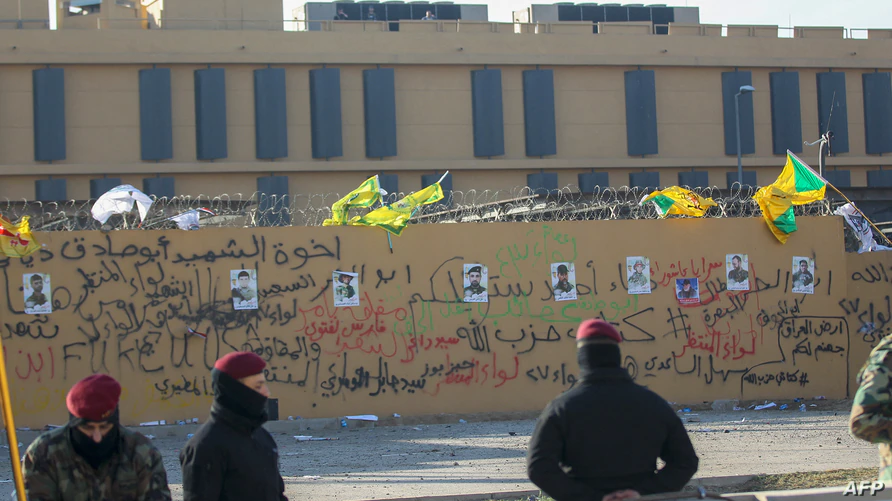The U.S. military Thursday struck facilities used by Iran-backed militia groups in eastern Syria, a decision the Pentagon said President Joe Biden authorized in response to recent attacks against U.S. personnel in Iraq.
“Specifically, the strikes destroyed multiple facilities located at a border control point used by a number of Iranian-backed militant groups,” including Kataeb Hezbollah and Kataeb Sayyid al-Shuhada, Pentagon spokesman John Kirby said in a statement.
Here is a look at the history and some facts about the two Iranian-backed militant groups:
Kataeb Hezbollah
Kataeb Hezbollah, or “Brigades of the Party of God,” is an Iraqi Shiite militia seen as the central nervous system of Iran’s Islamic Revolutionary Guard Corps’ Quds Force (IRGC-QF) in Iraq.
Although the group was officially founded in April 2007, its leaders have been actively engaged in anti-Western, pro-Iran activities since the 1980s and expanded their influence beginning in 2003 following the U.S. invasion of Iraq.
The U.S. State Department describes Kataeb Hezbollah as “a radical Shia Islamist group with an anti-Western establishment and jihadist ideology.” The U.S. State Department designated the group as a terrorist organization in July 2009.
On its official website, the group says it is an Islamic jihadist organization striving to, among other objectives, “foil the American project in the region, by defeating the occupation and expelling it from Iraq, failed and humiliated.”
The Shiite group publicly supports the Guardianship of the Jurist, a system of governance in Shiite Islam that gives the Islamic jurist guardianship over people and by which the Iranian theocrats rule. As such, Kataeb Hezbollah’s members see Iran’s Supreme Leader Ayatollah Ali Khamenei as their own spiritual leader.
“The establishment of the Islamic Republic in Iran is only an essential stage in preparing the ground for the State of Divine Justice and an example of the rulings of Islam and the Guardianship of the Jurist,” the group says on its website.
The U.S. government accuses the IRGC-QF of providing Kataeb Hezbollah with “lethal support” to target U.S.-led coalition and Iraqi security forces.
The U.S. believes the group has received millions of dollars from Tehran to fund its operations through Iraq and Syria. A lawsuit in November 2014 by U.S. veterans and family members of American soldiers killed in Iraq alleged that Iranian banks had funneled more than $100 million to militant groups such as Kataeb Hezbollah in Iraq.
U.S. officials believe that Lebanon’s Hezbollah militant group also has provided weapons and training for Kataeb Hezbollah members in Iran.
Structurally, the group is a part of Iraq’s Popular Mobilization Forces (PMF), an umbrella organization of several Iraqi Shiite militias formed in 2014 to push back against the Sunni extremist group Islamic State (IS) following the collapse of the Iraqi army in 2014.
According to the U.S. Military Academy’s Combating Terrorism Center, the group in 2011 had about 400 active members in Iraq. However, it has over the years recruited about 10,000 fighters and assigned about 2,500 of them to join the Syrian war on behalf of the regime of Bashar al-Assad.
The organization’s leader, Abu Mahdi al-Muhandis, was also the head of PMF until January 2020, when he was killed along with IRGC commander Qassem Soleimani in a U.S. airstrike near Baghdad’s airport. The group’s former secretary-general, Abdul Aziz al-Muhammadawi, locally known as Abu Fadak, replaced al-Muhandis as the PMF chief.
Since the defeat of the Islamic State in Iraq in December 2017, Kataeb Hezbollah has increased its efforts to gain political representation by directly participating in Iraqi parliamentary elections. The Fatih Alliance, a political alliance of Shiite militias that entered the 2018 elections with Kataeb Hezbollah’s participation, won the second-highest number of votes for the Iraqi parliament.
Additionally, the group has expanded its outreach to Iraqi society by establishing groups that recruit Shiite intellectuals, women and youths, such as the Academic Elites Foundation and al-Zainabiyat Foundation.
Kataeb Sayyid al-Shuhada
Kataeb Sayyid al-Shuhada or “The Masters of the Martyrs Brigade” was founded in 2013 in Iraq with the stated goal of defending Sayyidah Zaynab shrine, one of the holiest shrines for Shiite Muslims in southern Damascus, from radical Sunni Islamists.
The group’s goals, however, have since broadened to include resisting the presence of U.S. troops in both Iraq and Syria and propping up the Assad regime.
In a television interview in 2019, its leader, Abu Alaa al-Walae, threatened to take Iraq-based U.S. citizens hostage in the event of a possible war between Washington and Tehran.
In August 2013, Kataeb Sayyid al-Shuhada was widely accused of being involved in a chemical attack that killed hundreds of people in Syria’s East Ghouta suburb because of the group’s presence in the area. The group has not commented on the allegation, according to Stanford University’s Center for International Security and Cooperation.
The group maintains an active website where it publishes propaganda content about its activities and also about those of other Iran-backed proxy groups throughout the Middle East.
On Friday, Al-Walae turned to his Twitter account to announce his reaction to the U.S. airstrike.
“The American hostilities against the bases of our resistance brigade did not surprise us. That is expected [since] we are at war to liberate our land from the occupation,” he said.
 Eurasia Press & News
Eurasia Press & News



